Marketing teams face too many challenges that result in projects getting delayed or even postponed. The reason could be miscommunication, inefficiencies, forgotten tasks, or missed deadlines.
In order to regain control of the situation, Marketing Workflow Management comes in handy. Effective marketing workflows help your team streamline processes, boost productivity, and achieve better results.
But before delving into its details, let’s get into what marketing workflow is all about.
What is a marketing workflow management?
Marketing workflow management is the process of planning, organizing, executing, and optimizing all the steps involved in a marketing campaign. It involves creating structured workflows that define who does what, when, and how, ensuring that projects move smoothly from start to finish.
An effective marketing workflow structure helps teams collaborate better, meet deadlines, reduce bottlenecks, and maintain consistency across channels. It typically includes tools and systems for task assignment, approval processes, progress tracking, and communication.
It entails your to-do list, task sequence, and collaboration resources for the stakeholders and teams involved in the marketing objectives. The task structure can be as simple as a checklist of tasks and a spreadsheet. Or it can be as intricate as a visual diagram or a flowchart with “If X, then Y” decision branches.
What are the types of marketing workflow?
There are mainly six types of marketing workflows including:
- Content marketing workflow
- Email marketing workflow
- Social media workflow
- Software as a service marketing workflow
- Search engine optimization marketing workflow
1. Content marketing workflow: It is about making the content strategy process smooth and straightforward. Content marketing workflow helps keep everything organized from the beginning until the end. The aim is to create content that suits your audience perfectly.
Typical content marketing workflow:
Research & Planning > Content Creation > Editing & Proofreading > Publishing > Promotion & Distribution > Performance Tracking > Optimization
2. Email marketing workflow: The email marketing workflow guides the planning, execution, and optimization of email campaigns. It ensures that the emails are relevant and hit the right spot to keep your subscribers on their toes.
Typical email marketing workflow:
Audience Segmentation > Email Content Creation > Personalization & Optimization > A/B Testing > Scheduling & Sending > Performance Analysis > Refinement
3. Social media workflow: Social media workflow helps enhance the brand’s presence on different social media platforms. It keeps your social media strategy organized by simplifying everything from planning to posting on various platforms. Multiple workflows can be included due to varying forms of content.
Typical social media workflow:
Strategy Development > Content Creation > Scheduling & Publishing > Community Engagement > Monitoring & Analytics > Optimization
4. Collaboration workflow: Collaboration workflow improves team productivity and better communication by keeping everyone on the same page. It includes task management, performance tracking, feedback gathering, etc. Collaboration marketing workflow is helpful for cross-team marketing and co-branding partnerships.
Typical collaboration workflow:
Goal Setting > Task Assignment > Content Sharing > Feedback & Iteration > Approval Process > Final Execution > Review & Improvement
5. Software as a service marketing workflow: It focuses on attracting customers and converting them into long-term paying subscribers. SaaS marketing workflow involves content marketing, free trials, and targeted advertising. This marketing workflow relies on A/B testing, analytics, and automation.
Typical SaaS marketing workflow:
Market Research > Lead Generation > Lead Nurturing > Conversion Optimization > Customer Onboarding > Retention & Upselling > Performance Analysis
6. Search engine optimization marketing workflow: SEO marketing workflow helps to plan and execute SEO projects systematically. It focuses on consistently optimizing websites to gain organic traffic by improving SERP rankings.
Typical SEO marketing workflow:
Keyword Research > On-Page Optimization > Technical SEO > Content Development > Link Building > Performance Tracking > Continuous Optimization
Why efficient marketing workflow management is important?
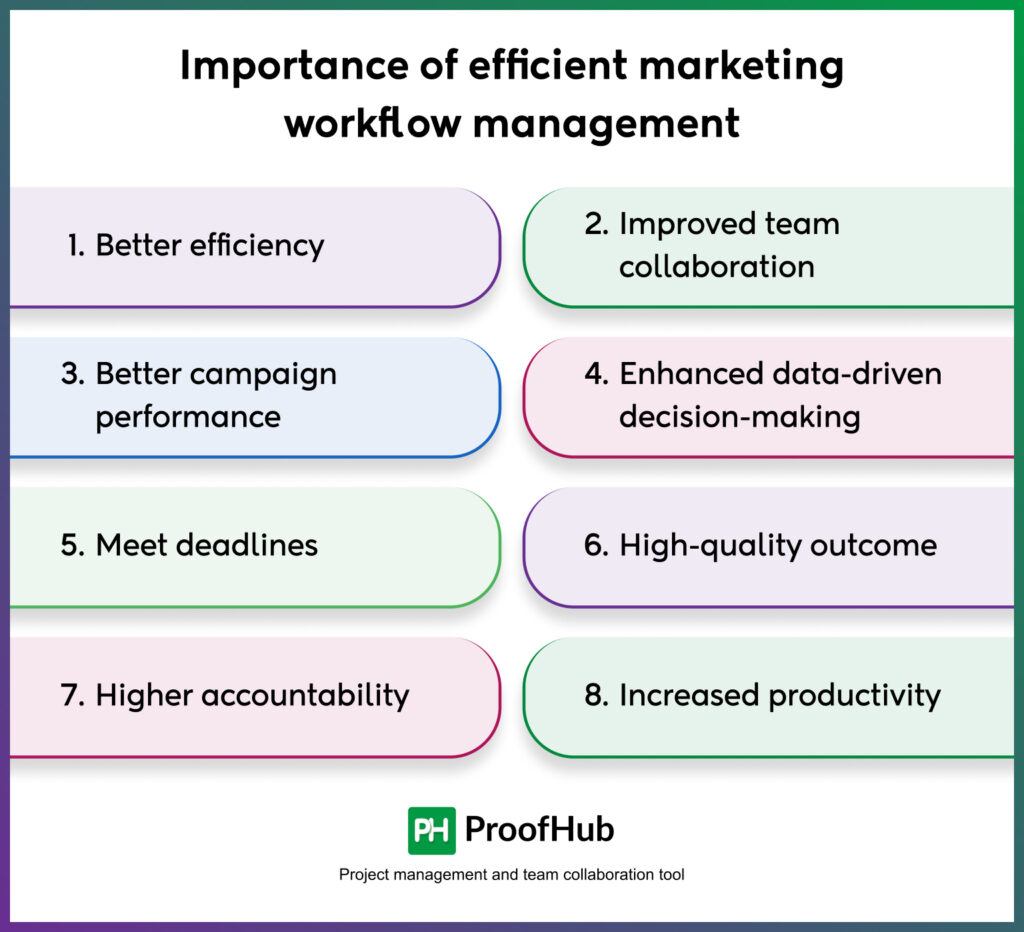
Immersing yourself in every intricate aspect of a marketing campaign is impossible for a project manager, especially at all times. However, not doing so could bring some unwanted surprises.
But does that mean you should let it unfold and derail the project?
No.
Implementing marketing workflow management not only lets you stay on top of your operations but adds value to your business process. It helps you reflect on your mistakes, promoting success in every dimension.
Here are some reasons why you should consider giving workflow management a thought.
1. Better efficiency
According to a research study, productivity lost in doing repetitive tasks costs more than $5 trillion annually.
Employees waste a major chunk of their time doing tasks that they have been doing for a long. Along with that comes the steps that unnecessarily eat up your time. This makes time management a tough target to achieve. But by automating these recurring tasks, you can save time and effort, eventually increasing efficiency.
2. Improved team collaboration
Marketing workflow is not merely a manual of all the marketing tasks and resources. This single script becomes a guide for team members, bringing everyone on the same page. It promotes team cohesion from across the organization. With clear communication channel setups, they can reach out to each other whenever required. Moreover, with an open communication protocol, you can even loop in stakeholders or team members to get important insights.
3. Better campaign performance
A lot of effort goes into designing a workflow for your marketing projects. It is a consensual handbook of strategies, practices, and parameters. Every project is given thoughtful consideration to streamline processes. With such clear instructions and guidelines defined, teams can work cohesively around this framework. Ensuring quality work and optimal resource utilization, the probability of making your campaign a success increases.
4. Enhanced data-driven decision-making
A workflow management system with centralized actions enhances visibility and transparency in your marketing workflow campaign. It acts as a central repository for all your documents, and provides comprehensive insights into progress, mitigating the need to juggle multiple applications together. Decision-makers and team members can utilize real-time insights to make informed decisions and refine their strategies.
5. Meet deadlines
Another way of measuring the effectiveness of your workflow is assessing if the tasks are executed in the defined timeframe. Because when deadlines are met, it promotes consistency and continuity in your workflow. Marketing workflow management minimizes inconsistencies and streamlines the campaign launches. This results in your team channeling their efforts into fueling overall campaign success.
6. High-quality outcome
A good marketing workflow helps you tap into your team’s full potential. After identifying your team’s expertise, you can leverage their skills and get the best out of each campaign component. Also, with standards clearly defined, locating errors and preventing major setbacks becomes possible in the first place. This way you can address issues promptly and prevent them from hampering your campaign progress ever again.
7. Higher accountability
“I wasn’t told to do this” or “I didn’t get it”
These statements are quite ordinary where there is a lack of a central source. However, a well-defined marketing strategy removes even the slightest scope of uncertainty. Make sure to clearly define the roles and responsibilities and set deadlines for getting tasks done on time. Also outlining the expectations from a task and visualizing the current task status enhances visibility across teams.
8. Increased productivity
With no defined outline, team efforts are scattered all around the air. It is like one team member performing a task, that provides no immediate benefit to the overall campaign. But in creating a workflow for your marketing campaign, you prioritize tasks based on the value they hold. Along with that, defining the dependency, tracking progress, and providing timely feedback refine the productivity standards of employees.
Enhance your understanding with this powerful guide to marketing project management
How to create your marketing department workflow?
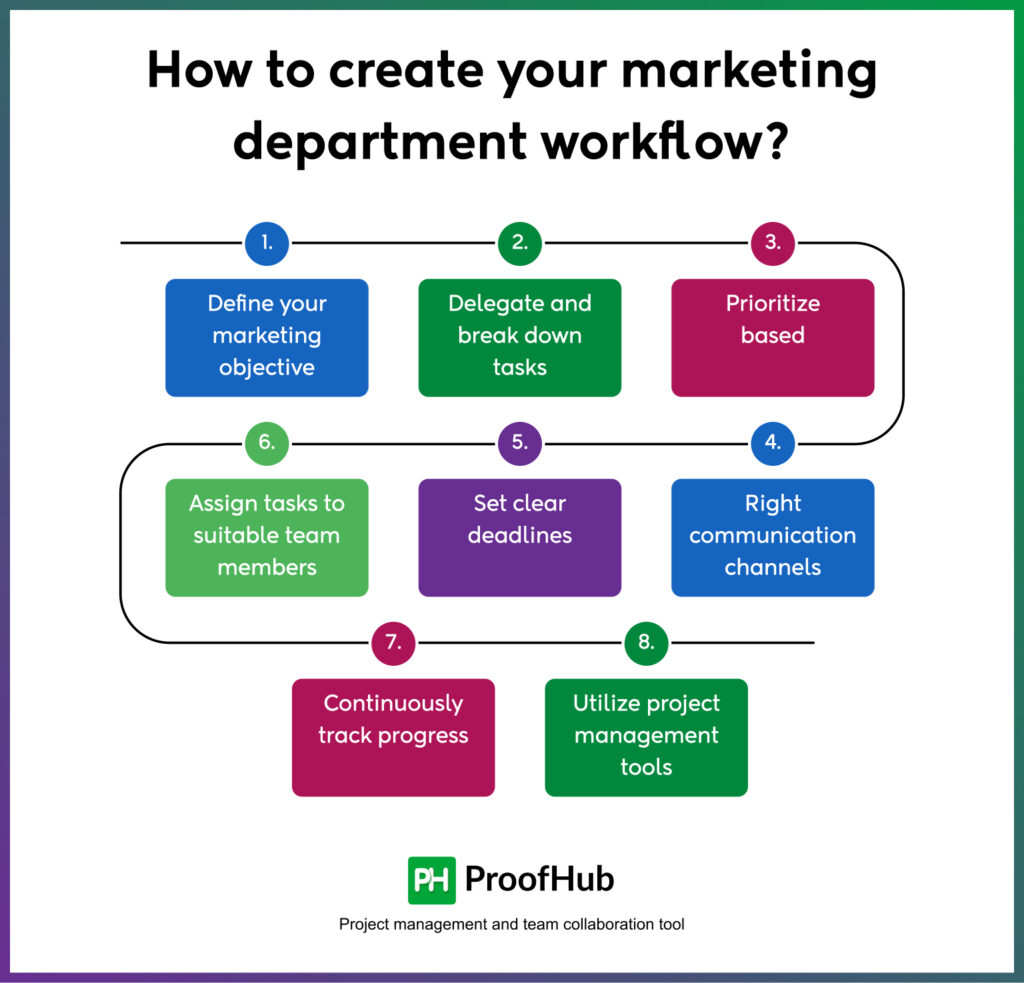
A lot of effort and planning goes into creating a marketing workflow process and executing it to achieve desired outcomes.
Some of the steps that go into drafting a plan include –
- Define your marketing objective
When starting to create a marketing workflow, make sure to identify your project goals and objectives. Assess what your marketing workflow should be centralized around and what you want to accomplish from it. When you and your team have a clear understanding of marketing objectives, you can align your operations around it to meet customers’ expectations.
- Delegate and break down tasks
Once you get your head around the objectives of your project, define the task to-do list. It is the next thing you should do for a successful project accomplishment. When done, divide the overarching marketing tasks into more manageable and actionable steps. You must not forget to decide their chronology for proper sequencing. These serve as the checkpoint to reaching your goals.
- Prioritize based on importance and urgency
After listing tasks, evaluating their priority levels becomes the next step. Executing tasks that provide the utmost value to your business goals or are urgently important should be your goal. When you do so, you ensure you stay agile towards emerging requirements and avoid situations that can lead to crises. Moreover, tackling these tasks first-hand improves productivity and efficiency.
- Assign tasks to suitable team members
With your task list in hand, start prepping up to initiate the transition from planning to action. For that, you need to thoroughly review and assess your team members’ capability and capacity. Make sure to match the right skill with the right task. Also, do not overburden anyone, just to achieve early results. This way you achieve balanced task distribution and ensure efficiency and expertise.
- Set clear deadlines and milestones
Consider figuring out the time each task will require to complete. Setting realistic deadlines and getting tasks executed in a certain period are as crucial as task prioritization. Make sure to set clear deadlines and milestones that provide direction to your team members. They should have a clear indication of what they need to achieve and the timeline in which they need to complete the task.
- Set up the right communication channels
Planning and strategizing are one thing. But when marketing communications are not cycling well, expecting high-quality results is challenging. Communication breakdown can frustratingly lead to missed deadlines, unexpected bottlenecks, and scattered efforts. Therefore setting up dedicated communication channels is necessary to keep your team members connected and informed.
- Continuously track progress and adjust
Staying on top of task progress is another major aspect of a marketing manager’s duty. You know what I am saying. You cannot stand still after delegating responsibility and setting deadlines. Evaluating your project’s performance and adjusting it to your requirements is vital for successful project completion. Regardless of the marketing campaign type.
- Utilize project management tools
For a successful marketing project execution, dedicated project management tools like ProofHub come in handy. They take the load off your shoulders by centralizing every project aspect in one dedicated location. You need not hop from one tool to another, or perform any manual actions. Just set these up, and you can focus all your efforts on what truly matters.
Example sof marketing workflow management
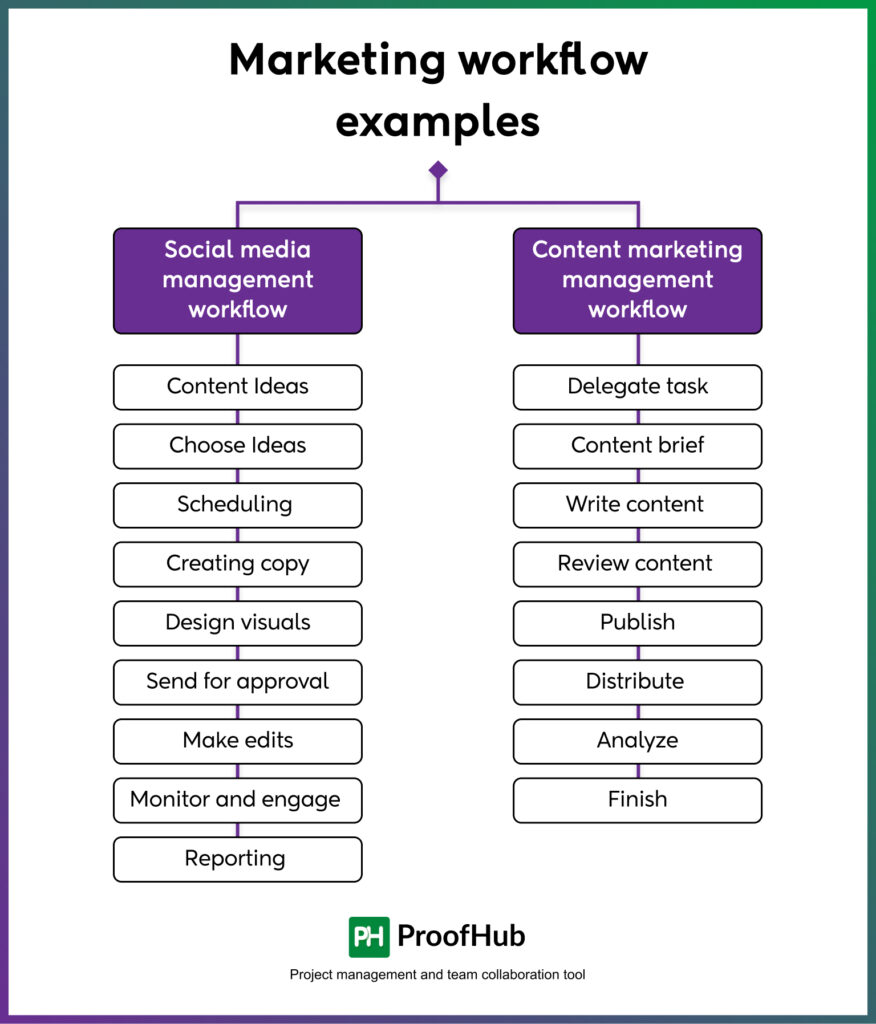
Let’s take a look at some of the marketing workflow examples. And evaluate how this structured approach ensures systematic progression from initiation to completion.
Social media management workflow
- Content Ideas
Develop a social media content calendar by listing all the content ideas that align with your social media campaign. Invite every suggestion and idea at this point.
- Choose Ideas
At this stage, select the posts that will best resonate with your strategy.
- Scheduling
With all the content ideas in hand, put together a schedule defining how everything will fit together.
- Creating copy
After the complete ideation of your exact needs, your copywriter or social strategist writes textual content called copy for social media posts.
- Design visuals
The approved copy is sent to the design team to create social media graphics or images.
- Send for approval
Now that your social media posts are ready, sending them for stakeholder approval is the next step. An online proofing tool like ProofHub can help you share files with stakeholders. They can make annotations using markup tools on the same file.
- Make edits
Here comes the opportunity to reflect on the feedback. Make rightful edits in one go without missing anything.
- Monitor and engage
After posting the content on social media platforms like Instagram, TikTok, etc., social media strategists should monitor trends and track activities. They should regularly engage with the audience through comments, interactions, and messages.
- Reporting
At last, social media strategists should simply pull together the data analysis into a campaign strategy. It provides insights into how posts are performing and generates marketing reports accordingly.
Content marketing management workflow
Content marketing is a subset of search engine optimization (SEO) marketing. It is a strategic outline of your goals and must align with your objectives. The steps included in the content marketing workflow management are –
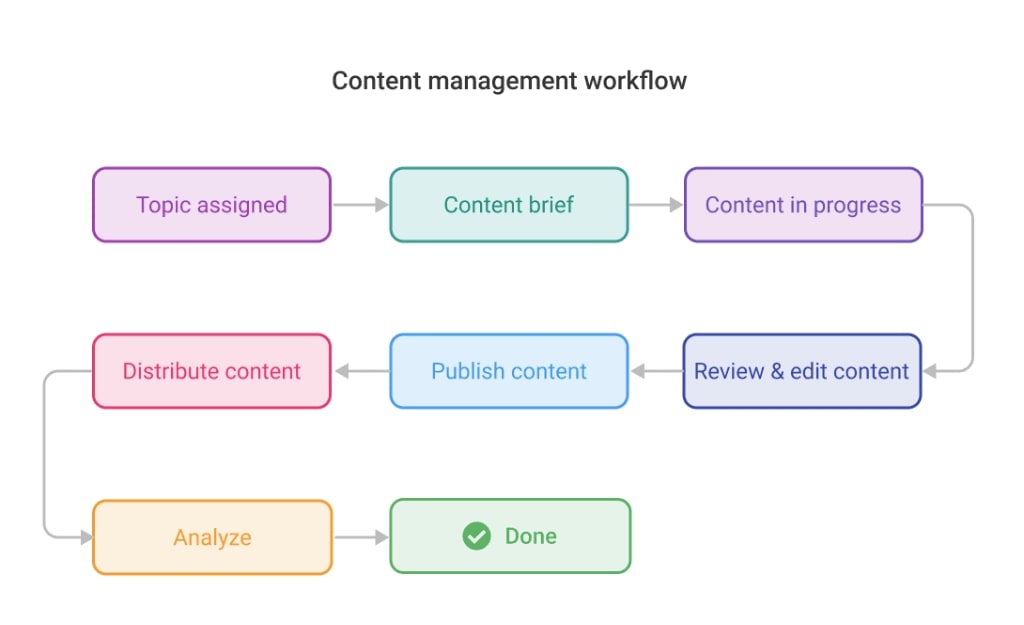
- Delegate task
Assigning a task to the writer you think could provide the best deliverable is the first and foremost thing to begin your workflow.
- Content brief
In the process of creating compelling content, topic and keyword research becomes the first thing to do. Both of these should align with your blog strategy, and help you rank on search engines.
- Write content
Now that you have given a content brief in your writer’s hand, copywriting high-quality content becomes obvious and essential. Make sure it aligns with the content workflow objective and resonates with the pain points of the audience.
- Review content
After the initial copy has been developed well, a second pair of eyes is required for proofreading the text. The editor will make suggestions that aid in improvement. Even typographical and grammatical errors are highlighted, ensuring the content meets quality standards.
- Publish
Once the content clarifies all the quality parameters, it is published.
- Distribute
Next comes promoting the content across various channels like LinkedIn, for lead generation.
- Analyze
To determine how the content is performing, make sure to perform content analysis and evaluations.
- Finish
Finally, the task is considered executed.
Explore the top 27 best marketing tools & software to grow your business
Best practices to optimize marketing campaign workflow
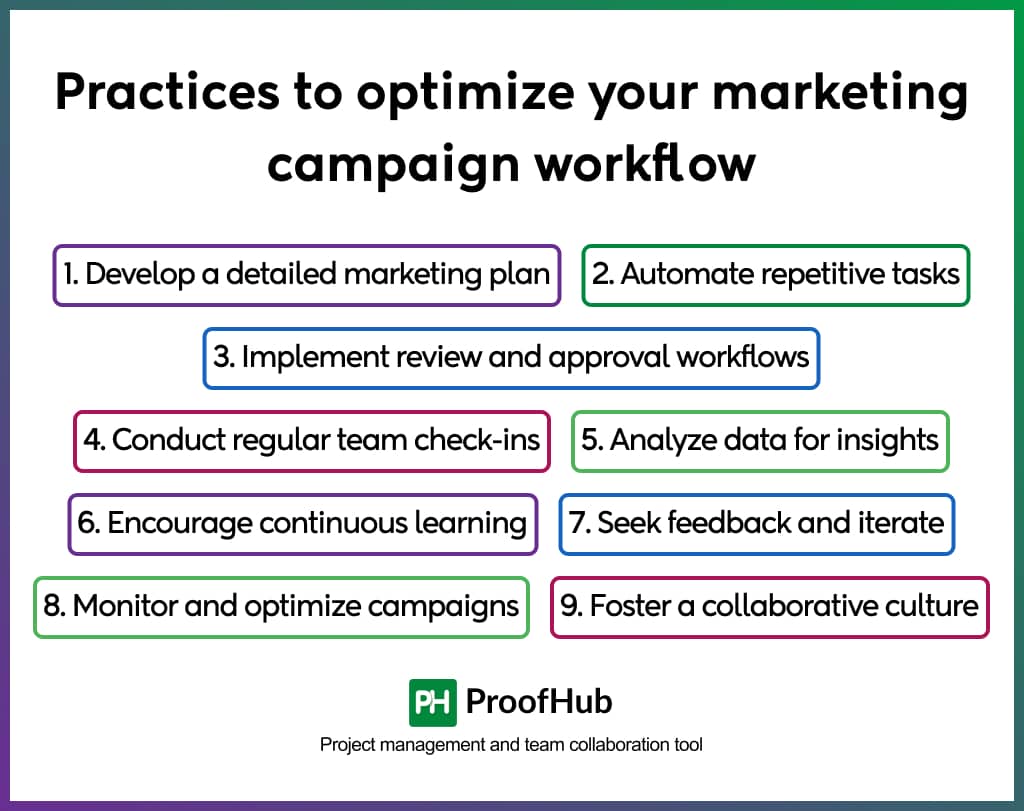
Creating workflows is a systematic way of outlining your goals and building a pipeline for your marketing campaign. However, the tendency for the workload to increase and progress to fall through the cracks is always there. These gaps can impact efficiency, quality, and overall results.
However, there are ways to enhance and elevate the effectiveness and greatness of your marketing campaign.
- Develop a detailed marketing plan
When drafting your marketing plan, make sure to take a deep dive. From outlining your goals and outcomes to defining strategies and tactics, it should cover all the comprehensive aspects of your campaign. This ensures clarity and alignment throughout the cycle.
- Automate repetitive tasks
Doing recurring tasks is not only tedious but frustrating. It could be anything from creating weekly reports to posting on social media, introducing automation in your operations saves you time. But cut the tendency to encounter a human error.
- Implement review and approval workflows
Establish a clear feedback process on your workflow. Why? Because by getting timely review and approval, you can progress with confidence. It also provides insights on whether the workflow is in alignment with your marketing guidelines.
- Conduct regular team check-ins
Asking your team for updates and progress regularly, keeps you updated on potential bottlenecks. Not only that, you get an opportunity to resolve challenges in time and maintain cohesiveness. Do not confuse regular check-ins with micromanaging.
- Analyze data for insights
Relying on a database to testify to its effectiveness is the best way to get a perspective on campaign alignment. For that, you must define your key performance indicators before the project hits full swing. The data-driven marketing provides enhanced visibility and transparency.
- Encourage continuous learning
Every marketing campaign is evolving in nature. Sometimes it also requires you to go the extra mile. But if you keep on learning and expanding your knowledge, you do not falter in the face of unexpected challenges.
- Seek feedback and iterate
Do not wait to seek or provide feedback. Go ahead and ask for it. Actively engaging in the feedback process, shows you the dynamics of your task progress. You can use these insights to refine your campaign for better outcomes in time.
- Monitor and optimize campaigns
Continuous monitoring of your campaign is crucial because of various parameters. It ensures all your team efforts are on the right track. Along with that, you also get a clear idea of where the work stands and whether it needs any modifications and adjustments.
- Foster a collaborative culture
Work culture greatly impacts employee productivity and eventually outcome. Foster an environment where both external and internal communication is a priority and not a choice. Following this, creativity and innovation naturally follow your lead.
Streamline your marketing workflow with a management software
Marketing workflow management serves as an efficiency catalyst. It not only saves you the extra hour your team always needs to tick things off the list. But also the operational costs that can surely weigh heavily on your budget. With good workflow management tools, marketing teams can avoid confusion, make fewer mistakes, and complete tasks on time.
ProofHub is a fantastic tool designed to make managing marketing tasks and projects easier. It brings together everything your team needs in one place, making it simpler to manage projects, communicate effectively, and collaborate smoothly.
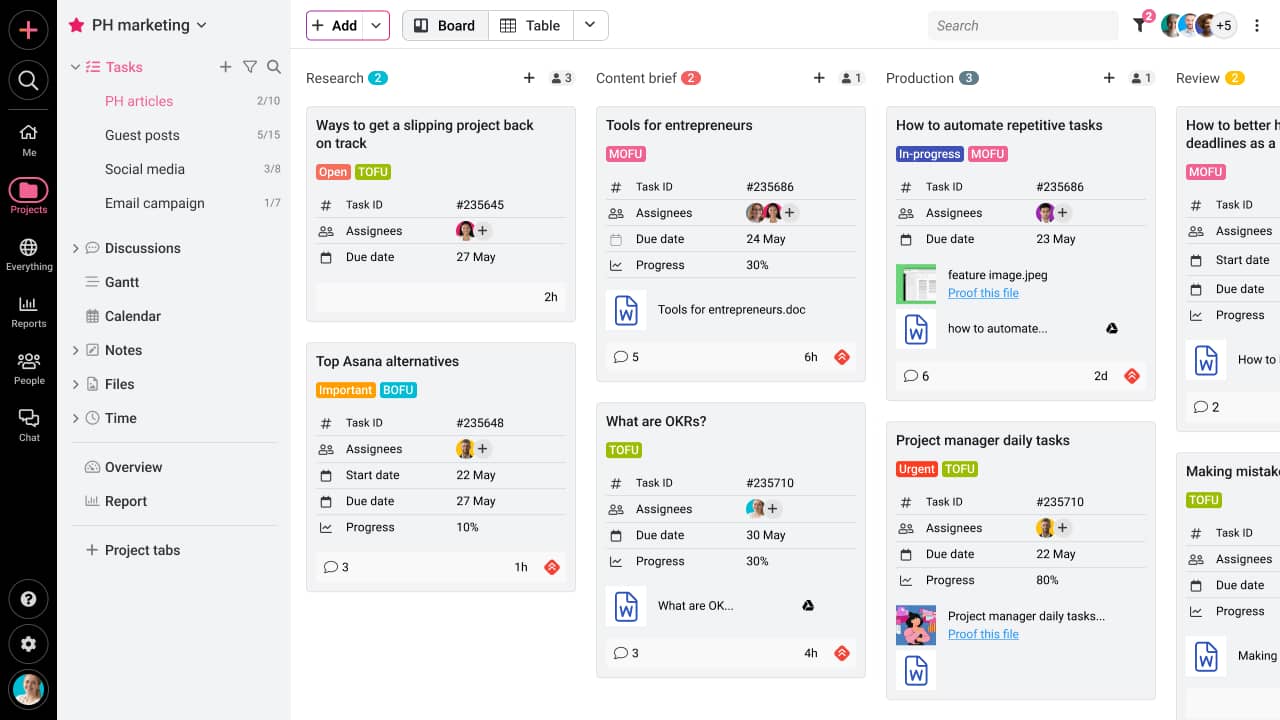
When it comes to handling workflow with ProofHub, managing all your B2C and B2B marketing campaigns becomes easy with its centralized platform. It introduces efficiency and effectiveness into your marketing operations by helping you –
- Get started on a project by tracking work requests and supporting queries using forms.
- Plan your workflow and visualize task dependencies with a Gantt chart.
- Divide and visualize tasks into workflow stages in table view.
- Communicate and collaborate in 1:1 or group conversations with built-in chat.
- Review, preview, and annotate documents and designs using its online proofing tool.
Conclusion
Using a marketing workflow will give you a streamlined process, better team collaboration, and successful marketing campaigns. Leveraging workflow tools like ProofHub simplifies project management tasks, automates repetitive tasks, and enhances team collaboration. Marketing workflow management is necessary for driving consistent growth.
If you have a well-defined workflow, handling the marketing campaigns will be easy.
Frequently asked questions
What are the characteristics of a good marketing workflow?
Efficiency, consistency, clearly defining goals, structured processes, proper use of tools, data-driven decision-making, and scalability in marketing tasks are some of the top characteristics of a good marketing workflow.
How can you manage your marketing workflow effectively?
To manage the marketing workflow effectively, you need to map the entire process correctly, automate tasks wherever possible, set clear deadlines, and use proper workflow tools.

